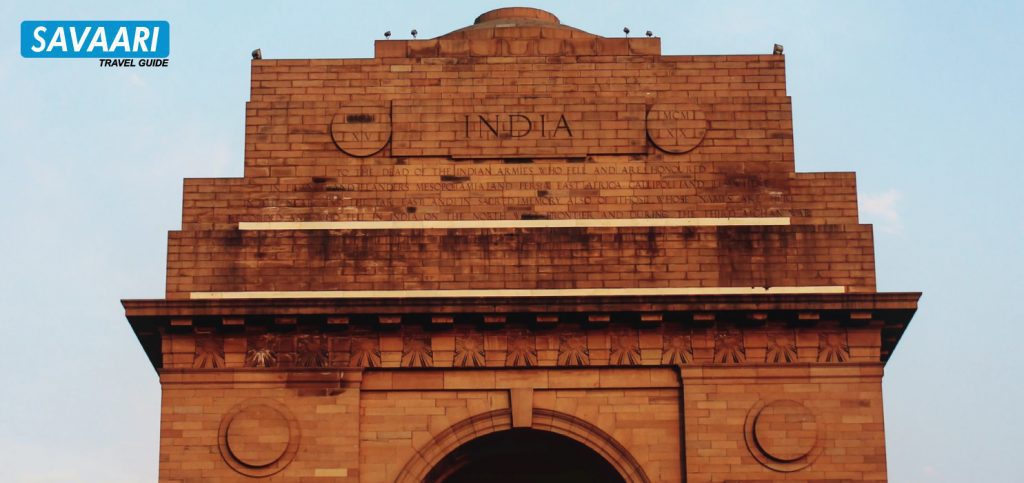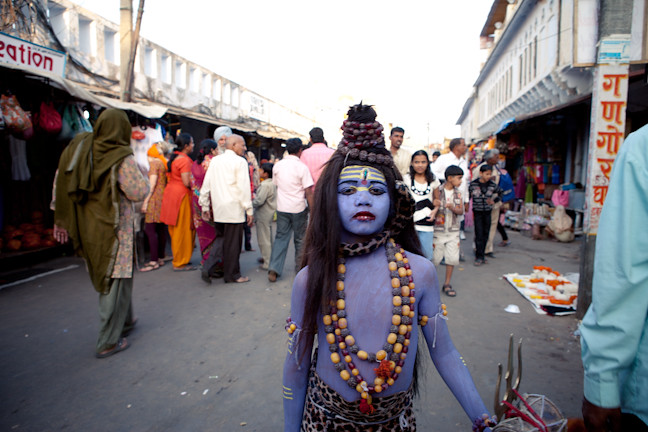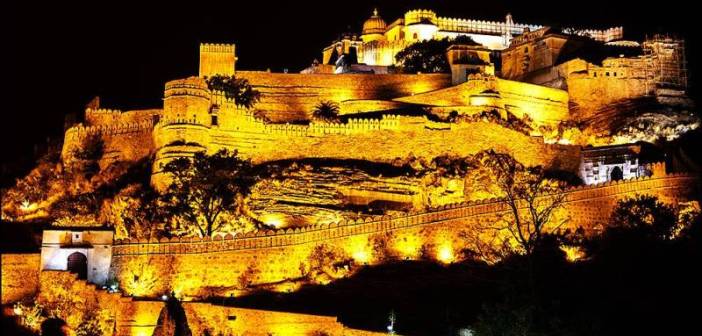Prepare to be mesmerized as we embark on a captivating journey through the majestic corridors of Hawa Mahal, an architectural gem nestled in the heart of Jaipur, India. Beyond its breathtaking facade and lattice windows, this splendid palace offers a myriad of unforgettable experiences for travellers. In this blog, we invite you to discover the top things to do in Hawa Mahal, where history, culture, and sheer beauty converge to create a truly enchanting atmosphere. From admiring the stunning views to immersing yourself in the rich heritage, get ready to book a cab and explore everything that the historic town of Jaipur has to offer. Popular as the “Palace of Winds”, Hawa Mahal is a remarkable sightseeing destination, famous for its rich past and cultural heritage in the Pink City – Jaipur. Keep scrolling to read the full travel guide.
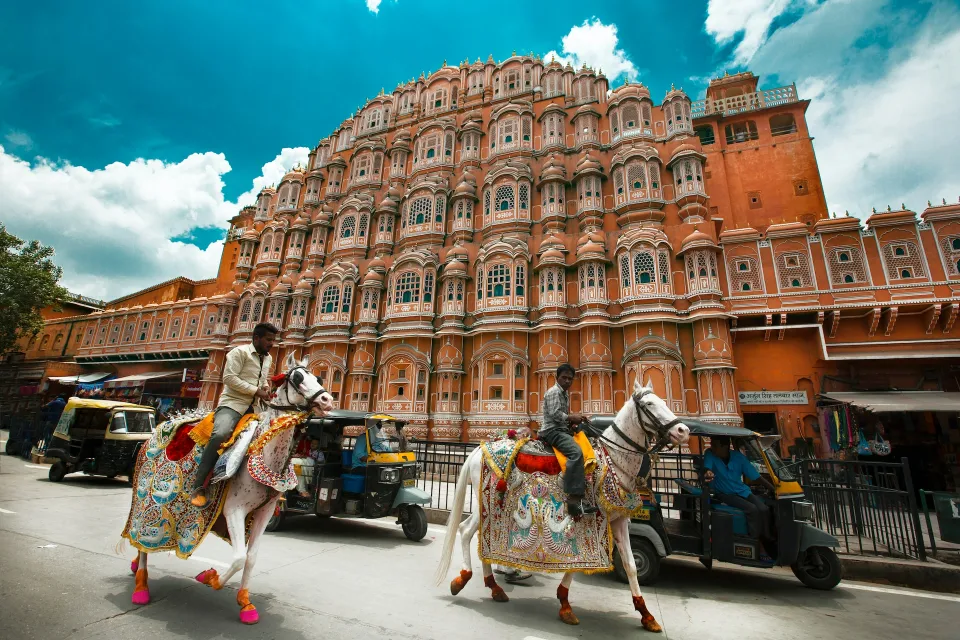
Table of Contents
- About
- Comprehensive guide to cover Hawa Mahal
- How to plan a trip to Hawa Mahal
- Hotels and Restaurants
- Useful links
About Hawa Mahal
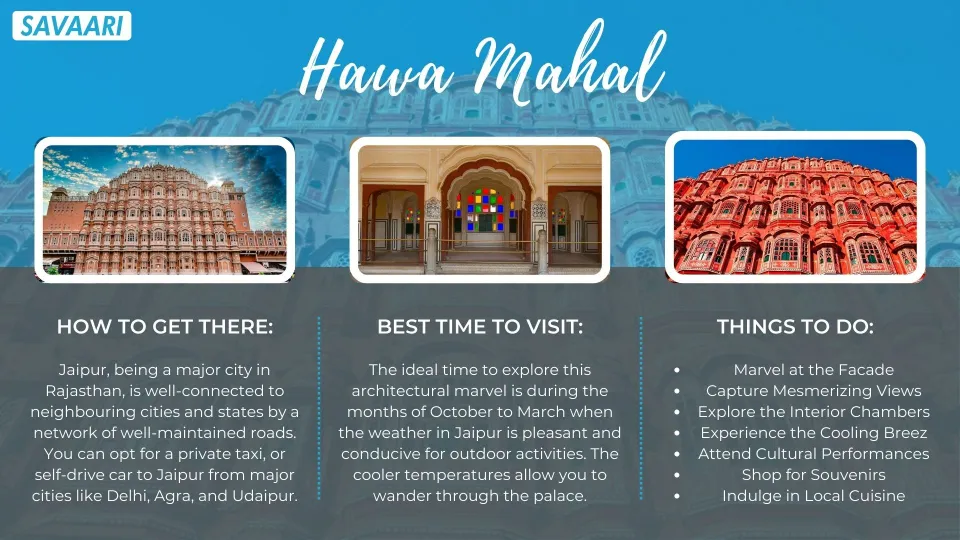
Hawa Mahal, also known as the “Palace of Winds,” is a fascinating architectural masterpiece nestled in the heart of Jaipur, India. Built in 1799, this iconic structure showcases a stunning front adorned with intricately designed windows and screens. These honeycomb-like jharokhas served as a means for the royal women to observe the outside world while maintaining their privacy. Stepping inside, visitors are transported to a bygone era. They can marvel at the beautiful frescoes, delicate mirror work, and regal chambers that once housed the royal women. With its rich history, resplendence, and unique design, Hawa Mahal continues to be a mesmerizing symbol of Rajasthan’s architectural brilliance.
History
Hawa Mahal is a historical monument that holds a significant place in the cultural and architectural heritage of Jaipur, Rajasthan. Constructed in 1799 by Maharaja Sawai Pratap Singh, it was designed by Lal Chand Usta in the form of a five-story beehive-shaped structure. The purpose of its construction was to provide a place for the royal women to observe the lively street processions and festivities of the city without being seen. The delicate latticework, jharokhas, and windows allowed for ventilation, ensuring a cool breeze circulated throughout the palace. Today, Hawa Mahal stands as a splendid symbol of the rich history, majesty, and architectural brilliance of Jaipur’s royal past.
Architecture
The architecture of Hawa Mahal is a captivating testament to the creative genius of the Rajput era. This architectural marvel showcases a unique and elaborate design that is both functional and visually striking. The most prominent feature of the palace is its stunning facade, which is adorned with a symphony of delicate latticework, ornate balconies, and elaborate domes.
The facade of Hawa Mahal boasts over 900 intricately carved jharokhas, or small windows. These are arranged in a honeycomb-like pattern. These jharokhas serve a dual purpose – they provide ventilation and allow for a cool breeze to pass through, earning the palace its name, “Palace of Winds.” These were designed to offer the royal women a discreet vantage point to observe the activities of the city without being seen, as they followed the purdah system.
The architectural style of Hawa Mahal is a fusion of Rajput and Mughal influences. The palace is constructed using pink sandstone, a signature hue of Jaipur, giving it a distinctive appearance. The detailing and delicate motifs seen throughout the structure reflect the craftsmanship and artistic finesse of the time. The palace rises five stories high, with each floor featuring beautifully adorned chambers and corridors that once served as private quarters for the royal women.
Overall, the architectural design of Hawa Mahal is a breathtaking amalgamation of beauty, functionality, and cultural significance. It stands as a remarkable testament to the architectural brilliance of the past. It continues to captivate visitors with its unique charm and grandeur.
Lesser known facts about Hawa Mahal
Hawa Mahal is not just a stunning architectural masterpiece but also holds many lesser-known facts that add to its allure. Join us as we delve into the intriguing secrets and fascinating stories that make Hawa Mahal even more captivating.
- Purposeful architecture: While Hawa Mahal is undoubtedly a breathtaking sight to behold, its unique design goes beyond aesthetics. The palace’s honeycomb-like facade, with its numerous small windows and screens, was intentionally crafted to facilitate natural ventilation and keep the interior cool during the scorching Rajasthan summers.
- The five stories, but not quite: At first glance, Hawa Mahal appears to have five stories. However, upon closer inspection, it becomes evident that the palace has several tiers, with the main structure comprising only one storey. The additional levels are cleverly designed to create the illusion of a multi-storey palace.
- A hidden escape route: In times of emergency, the palace offered a secret escape route for the royal occupants. Concealed passages and stairways leading from the chambers of Hawa Mahal to the adjoining City Palace, allowing the royals to swiftly exit and avoid any potential dangers.
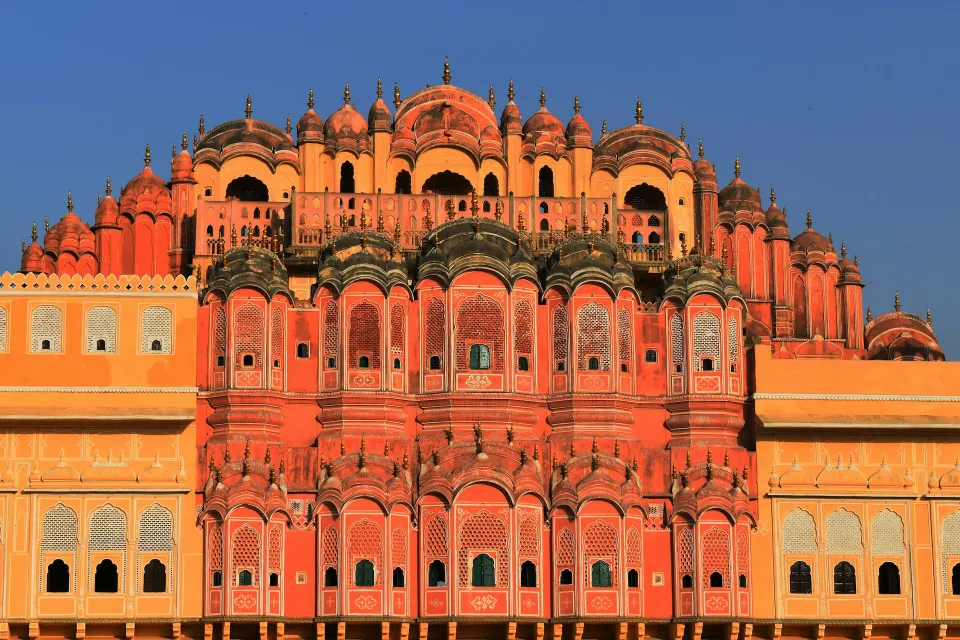
- The lack of a main entrance: One of the most intriguing aspects of Hawa Mahal is the absence of a grand main entrance. Instead, the palace was designed to be accessed through the backside, connecting it to the City Palace complex. This deliberate architectural choice aimed to maintain the privacy and exclusivity of the royal residents.
- Symbolic colours: The striking pink colour of Hawa Mahal holds deeper symbolism. The pink sandstone, used extensively in the construction, represents hospitality and welcome in the Rajasthani culture. The vibrant hue has become synonymous with Jaipur and is often referred to as “Jaipur Pink.”
- A haven for artisans: During its prime, Hawa Mahal was not just a residence for the royal women but also provided a haven for skilled artisans. The chambers within the palace housed various workshops where talented craftsmen worked on exquisit artwork, paintings, and embroidery, creating masterpieces that adorned the palace walls.
- Witness to royal celebrations: Hawa Mahal has witnessed numerous grand celebrations and festivities during its illustrious history. The palace’s balconies and jharokhas served as prime vantage points for the royal family to witness processions, cultural performances, and religious ceremonies taking place in the city streets below.
- Inspiring filmmakers and artists: The enchanting beauty and architectural splendour of Hawa Mahal has captivated the imagination of filmmakers and artists for decades. The palace has been featured in several Bollywood films, adding to its iconic status and making it a popular backdrop for visual storytelling.
- Preservation and restoration: Over the years, Hawa Mahal has undergone meticulous restoration efforts to preserve its historical and architectural significance. These preservation initiatives ensure that future generations can continue to admire and appreciate the magnificence of this cultural gem.
Things to do in Hawa Mahal
Hawa Mahal, with its timeless allure and architectural grandness, offers visitors a multitude of enriching experiences to savour. Immerse yourself in the royal ambience and embark on a journey of discovery as we explore the top things to do within the hallowed walls of this iconic palace.
- Marvel at the fascinating facade: Begin your Hawa Mahal adventure by marvelling at the facade that gives the palace its distinct identity. Take your time to appreciate the delicate latticework, ornate balconies, and exquisite domes. Let the beauty of the honeycomb-like structure captivate your senses and transport you to a bygone era.
- Capture mesmerizing views: Climb to the upper levels of Hawa Mahal to enjoy panoramic views of the bustling streets of Jaipur. The vista from the palace’s numerous jharokhas is truly enchanting, offering a unique perspective of the city’s vibrant life. Bring your camera along and capture the breathtaking scenes unfolding below.
- Explore the interior chambers: Step inside and explore the interior chambers of Hawa Mahal, which reveal the opulent lifestyle of the royal women. Admire the vibrant frescoes, intricate mirror work, and detailed carvings that adorn the walls, ceilings, and pillars. Each chamber tells a story of the palace’s illustrious past.
- Experience the cooling breeze: Stand by the jharokhas and feel the gentle breeze that passes through the lattice windows. Close your eyes and imagine the royal women relishing the cool air as they observed the world outside. Let this natural ventilation system transport you to a time of regal elegance and refined living.
- Attend cultural performances: Hawa Mahal often plays host to cultural performances and events that showcase the rich heritage of Rajasthan. Check the schedule and be a part of mesmerizing dance and music performances that bring the palace to life. Immerse yourself in the vibrant traditions and artistic expressions of the region.
- Discover the history at the museum: Visit the on-site museum within Hawa Mahal to delve deeper into its history and significance. The museum houses a collection of artefacts, photographs, and exhibits that provide insights into the palace’s construction, architectural style, and the lives of the royal occupants. Enhance your understanding of this architectural masterpiece.
- Shop for souvenirs: Take a stroll through the surrounding bazaars and streets, where you’ll find an array of shops selling local handicrafts, textiles, and souvenirs. Pick up a memento to commemorate your visit to Hawa Mahal and support local artisans.
- Indulge in local cuisine: After immersing yourself in the regal ambiance of Hawa Mahal, treat your taste buds to the flavours of Rajasthan. Indulge in a culinary adventure by sampling local delicacies and traditional Rajasthani cuisine at nearby restaurants and eateries.
Places to visit near Hawa Mahal
While Hawa Mahal enchants visitors with its architectural marvel, the surrounding area offers a plethora of attractions that further enrich your Jaipur experience. Discover the vibrant tapestry of history, culture, and natural beauty as we explore the top places to visit near Hawa Mahal.
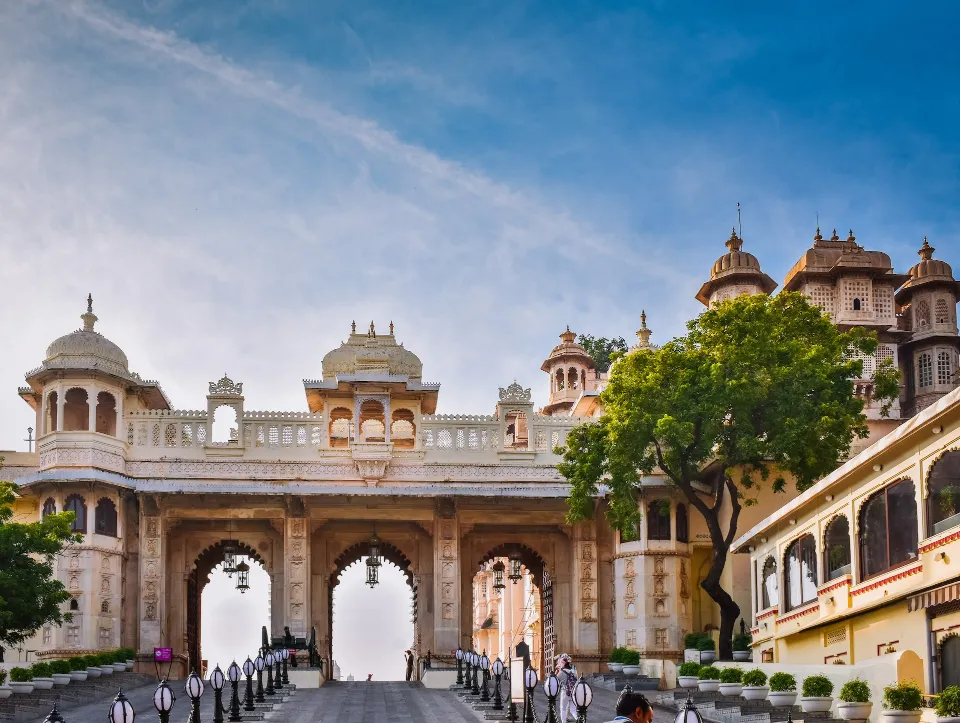
- City Palace: Just a stone’s throw away from Hawa Mahal lies the magnificent City Palace, a sprawling complex that showcases the grandeur of the Rajputana dynasty. Explore its opulent halls, courtyards, and museums. You can witness royal artefacts, and art collections, and a glimpse into the lives of the erstwhile rulers of Jaipur.
- Timing: 9:30 am to 5:00 pm
- Entry Fee: ₹200 for adults, ₹100 for children
- Nahargarh Fort: Perched on the Aravalli Hills, Nahargarh Fort offers breathtaking panoramic views of Jaipur’s skyline. Explore the fort’s intelligent architecture, visit its historical rooms, and take a leisurely stroll through the lush gardens. Capture stunning photographs of the cityscape from the fort’s vantage points.
- Timing: 10:00 am to 5:30 pm
- Entry Fee: ₹200 for adults, ₹50 for students
- Jal Mahal: Just a short drive from Hawa Mahal, Jal Mahal is a picturesque palace. It floats on the serene waters of Man Sagar Lake. Admire the exquisite Rajput and Mughal architectural elements of the palace and enjoy the serene ambience. Take a boat ride on the lake to get closer to this architectural phenomenon.
- Timing: Open all day for exterior view; boat rides available from 9:00 am to 5:00 pm
- Entry Fee: ₹50 for Indian nationals, ₹100 for foreigners (boat ride charges separate)
- Albert Hall Museum: Located within the stunning Ram Niwas Garden, Albert Hall Museum is a treasure trove of art, artefacts, and historical exhibits. Explore the vast collection of sculptures, paintings, textiles, and ancient artefacts that showcase the rich heritage of Rajasthan.
- Timing: 9:00 am to 5:00 pm
- Entry Fee: ₹150 for adults, ₹40 for students
- Bapu Bazaar and Johari Bazaar:
- For a delightful shopping experience, head to Bapu Bazaar and Johari Bazaar. These bustling markets offer a vibrant mix of traditional clothing, jewellery, handicrafts, and local delicacies. Lose yourself in the vibrant colours and immerse yourself in the local culture.
- Timing: 11:00 am to 9:00 pm (Varies by individual shops)
- Jaipur Wax Museum: Indulge your curiosity at the Jaipur Wax Museum. It is where lifelike wax statues of renowned personalities from various fields await. Pose for photos alongside celebrities, historical figures, and cultural icons, creating unforgettable memories.
- Timing: 10:00 am to 6:30 pm
- Entry Fee: ₹300 for adults, ₹200 for children
- Galta Ji Temple: Immerse yourself in spirituality and tranquillity at Galta Ji Temple, also known as the Monkey Temple. Set amidst the hills, this temple complex offers a peaceful escape and is inhabited by playful monkeys. Explore the temples, soak in the serene atmosphere, and witness the evening aarti (prayer ceremony).
- Timing: 5:00 am to 9:00 pm (Varies for specific temple rituals)
- Entry Fee: No entry fee, but donations are appreciated
Planning a trip to Hawa Mahal
To make the most of your visit to Hawa Mahal, careful planning is essential. Begin by determining the best time to go, taking into account the weather and tourist seasons. It would be best to avoid the extremely hot season. Next, decide on the duration of your visit and allocate sufficient time to explore the palace and its surroundings. Research the entry fees and any guided tours available to enhance your understanding of the palace’s history and construction.
Consider booking your tickets in advance to avoid long queues. Additionally, familiarize yourself with the location and plan your transportation accordingly, whether it’s hiring a cab, using public transportation, or opting for a guided tour. Lastly, remember to pack essentials such as comfortable shoes, sun protection, and a camera to capture the magical moments within the palace. With a well-planned trip, you can immerse yourself in the beauty of Hawa Mahal. This will help you create lasting memories of this architectural gem.
How to reach Hawa Mahal
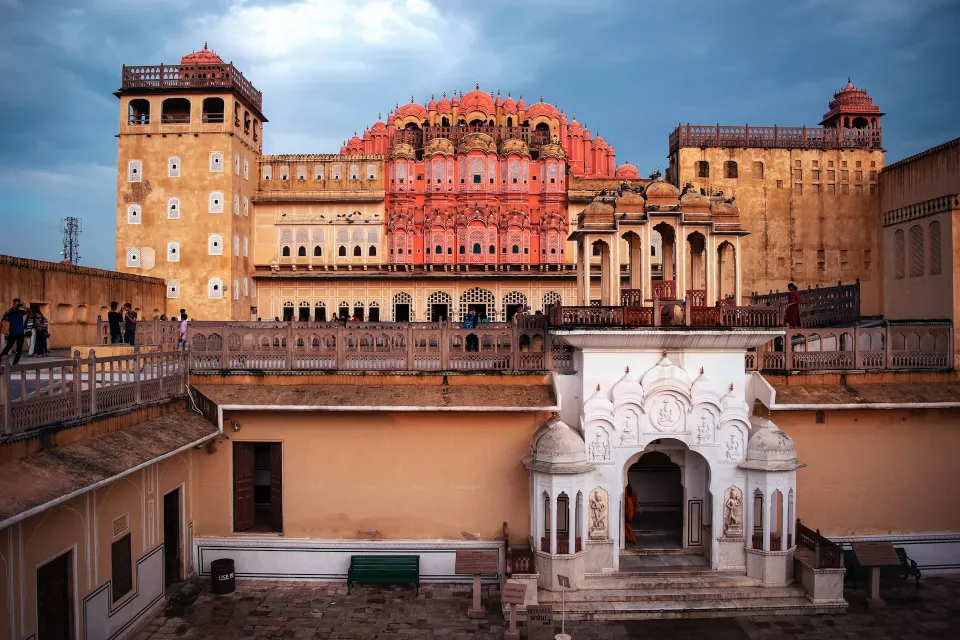
Hawa Mahal, located in the heart of Jaipur, is easily accessible through various modes of transportation. Whether you prefer travelling by road, air, or train, here’s a comprehensive guide to help you reach this architectural marvel.
By Road:
Jaipur, being a major city in Rajasthan, is well-connected to neighbouring cities and states by a network of well-maintained roads. You can opt for a private taxi, or self-drive car to Jaipur from major cities like Delhi, Agra, and Udaipur. National Highways such as NH8, NH11, and NH12 provide convenient access to Jaipur.
By Air:
If you prefer air travel, Jaipur International Airport is the nearest airport to Hawa Mahal. Located approximately 13 kilometers from the palace, the airport receives both domestic and international flights. From the airport, you can hire a taxi or take a pre-paid cab to reach Hawa Mahal within a short drive.
By Train:
Jaipur Junction, the main railway station in Jaipur, is well-connected to major cities across India. Several trains, including express and superfast trains, operate on this route. Once you arrive at Jaipur Junction, you can hire a taxi to reach Hawa Mahal, which is located approximately 4 kilometers away.
Best time to visit Hawa Mahal
Choosing the right time to visit Hawa Mahal can greatly enhance your experience of this iconic palace. The ideal time to explore this architectural marvel is during the months of October to March when the weather in Jaipur is pleasant and conducive for outdoor activities. The cooler temperatures allow you to wander through the palace without discomfort, taking in the intricate details and mesmerizing architecture. Additionally, this period coincides with several festivals and events in Jaipur, such as Diwali and the Jaipur Literature Festival, adding an extra charm to your visit.
However, it’s important to note that this is also the peak tourist season, so expect larger crowds. If you prefer a quieter and more peaceful visit, consider planning your trip during the shoulder seasons of April to June or September to November. This is when the weather is still favourable and the tourist influx is relatively lower. Avoid visiting during the summer months of May and June, as temperatures can soar, making it uncomfortable to explore the palace. By selecting the best time to visit Hawa Mahal, you can immerse yourself in the beauty and grandeur of this architectural masterpiece, creating unforgettable memories that will last a lifetime.
Timing and entry fees for Hawa Mahal
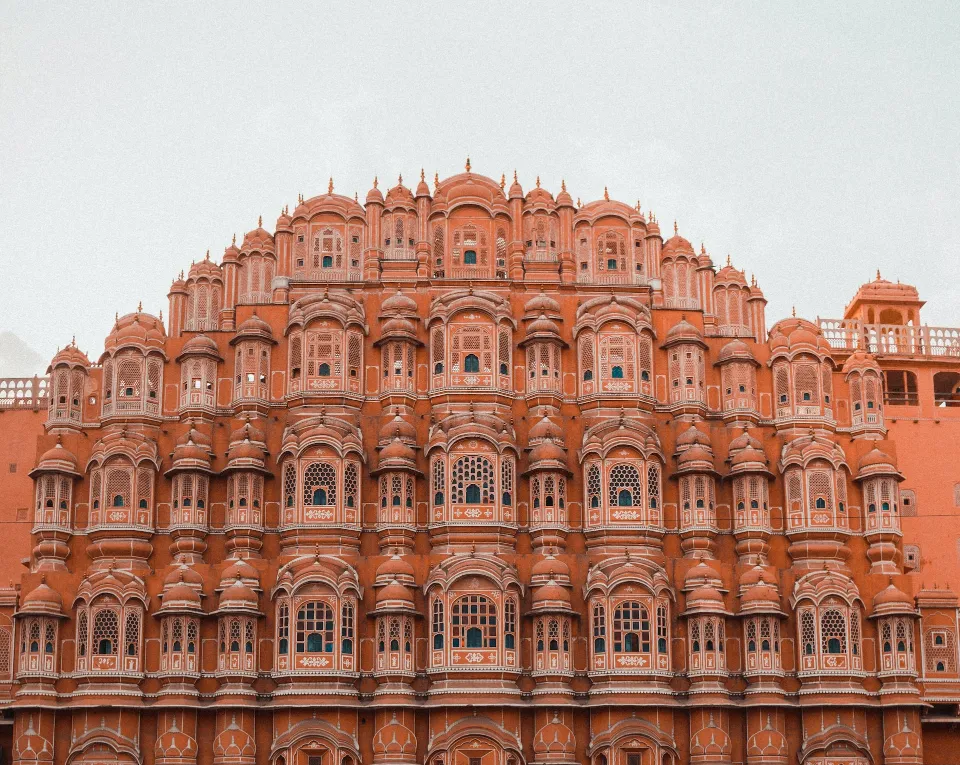
Before embarking on your journey to Hawa Mahal, it’s important to be aware of the timing and entry fees to ensure a smooth and hassle-free experience. Here’s all the essential information you need:
- Timing: Hawa Mahal is open for visitors every day of the week, from 9:00 am to 4:30 pm. It’s recommended to plan your visit during these hours to fully appreciate the beauty of the palace. Arriving early in the morning or late in the afternoon can help you avoid large crowds and make the most of your time exploring this architectural gem.
- Entry Fees: To enter Hawa Mahal a nominal entry fee is applicable. For Indian nationals, the entry fee is ₹50 per person, while for foreign tourists, it is ₹200 per person. Keep in mind that these fees are subject to change, so it’s always a good idea to verify the latest rates before your visit.
- Photography and Additional Charges: If you wish to capture the magnificent beauty of Hawa Mahal through your camera lens, an additional fee of ₹10 is levied for still photography. However, videography is not allowed inside the palace premises. It’s worth noting that there may be separate charges if you plan to bring professional cameras or equipment.
- Guided Tours: To enhance your understanding of Hawa Mahal’s history and significance, guided tours are available for a more immersive experience. These tours provide detailed insights into the architecture, stories, and legends associated with the palace. Moreover, the fees for guided tours may vary depending on the duration and depth of the tour but ranges from around Rs. 400 onwards.
Travel trips to Hawa Mahal
When visiting the iconic Hawa Mahal in Jaipur, India, there are a few travel tips to keep in mind. Firstly, it’s advisable to arrive early in the morning to beat the crowds and enjoy a more peaceful experience. Remember to dress modestly as a sign of respect for the cultural heritage and religious significance of the site. Comfortable footwear is recommended as you will be exploring the multiple levels and architecture. Don’t forget to carry sunscreen, a hat, and plenty of water, as the desert climate can be harsh. Hiring a local guide can enhance your understanding of the history and architectural nuances of Hawa Mahal. Finally, make sure to bring your camera as you’ll want to capture the stunning lattice windows and ornate façade that make Hawa Mahal a true marvel to behold.
Savaari customer verified: Places to eat near Hawa Mahal
Exploring the exquisite beauty of Hawa Mahal can work up an appetite, and luckily, there are numerous dining options available in the vicinity to satisfy your cravings. Here are some delightful eateries near Hawa Mahal that offer a diverse range of flavours:
- LMB – Laxmi Misthan Bhandar, Johari Bazaar, Jaipur: LMB is a renowned culinary institution, serving authentic Rajasthani cuisine since 1954. Indulge in their signature dishes like Dal Baati Churma (lentils and baked bread served with a sweet powdered mix), Gatte ki Sabzi (gram flour dumplings in a spicy curry), and the delectable Rajasthani thali (a platter of assorted regional delicacies). Don’t miss their mouthwatering sweets, such as Ghewar and Rabri, to complete your culinary experience.
- Niros, MI Road, Jaipur: Niros is a legendary restaurant in Jaipur, known for its nostalgic ambience and flavoursome food. Treat yourself to their famous non-vegetarian dishes like Laal Maas (spicy red meat curry), Jungli Maas (traditional wild game meat), and a variety of succulent kebabs. Vegetarian options like Dal Makhani (buttery lentils) and Paneer Tikka are equally delightful. Finish your meal with their special Rabri and Kesar Kulfi.
- Rawat Mishtan Bhandar, Sindhi Camp, Jaipur: Rawat Mishtan Bhandar is a popular eatery famous for its mouthwatering Pyaaz Kachori (deep-fried pastry filled with spiced onion) and Mirchi Bada (deep-fried chilli fritters). These savoury snacks are a must-try when in Jaipur. The shop also offers a wide variety of traditional sweets. This includes Rasgulla, Ghevar, and Malpua, perfect for satisfying your sweet tooth.
- Peshawri – ITC Rajputana, Palace Road, Jaipur: For a luxurious dining experience, head to Peshawri. It is an award-winning restaurant known for its authentic North Indian cuisine. Delight in their signature dishes like Dal Bukhara (slow-cooked black lentils), Murgh Malai Kabab (creamy chicken kebabs), and the delectable range of freshly baked bread from their tandoor. The rich flavours and warm hospitality make this restaurant a true culinary gem.
Places to Stay near Hawa Mahal
If you’re planning a visit to Hawa Mahal, finding suitable accommodation near the palace is essential for a comfortable and convenient stay. Here are some recommended hotels located in close proximity to Hawa Mahal.
| Hotel name | Distance | Number |
| Hotel Pearl Palace | 1.5 km Approx. distance from the city centre | 094142 36323 |
| Alsisar Haveli | 1 km Approx. distance from the city centre | 0141 236 8290 |
| Umaid Bhawan Heritage Hotel | 2.5 km Approx. distance from the city centre | 0141 220 1954 |
Travelling to Hawa Mahal is an experience that allows you to delve into the rich heritage and architectural marvels of Jaipur. The iconic “Palace of Winds” stands as a testament to the city’s royal past. It offers a glimpse into the intricate craftsmanship and ingenious design of the bygone era. Exploring the chambers, climbing up the narrow staircases, and witnessing the breathtaking views of the city from the top are moments that will stay with you forever. Download Savaari App to ensure a seamless trip to the iconic monument. Hawa Mahal is a true gem of Jaipur, inviting travellers to unravel its secrets and soak in the magnificence of Rajasthan’s architectural heritage.
Useful links
- Official website of Hawa Mahal
- Rajasthan-special luxury train
- Information on fairs and festivals in Jaipur
Last Updated on January 17, 2024 by Swati Deol



